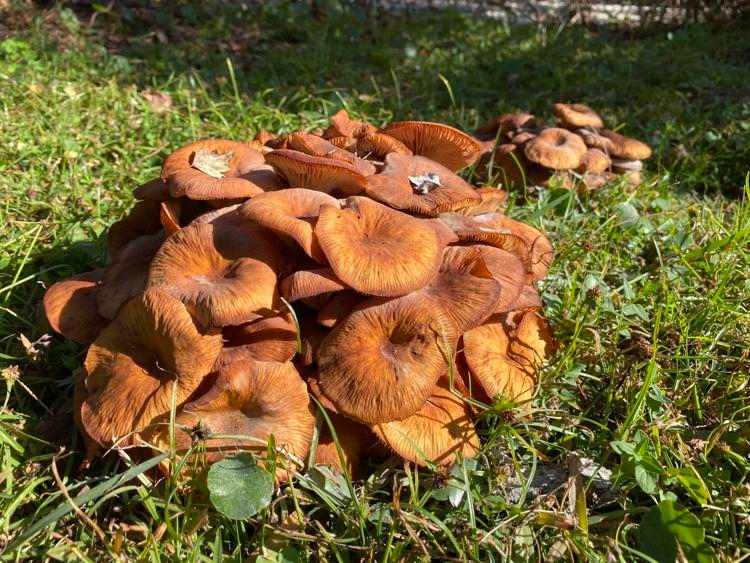The honey mushrooms of the South

One mushroom has been blooming in lawns and around the base of stumps this November. It grows in dense clumps like an earthy bouquet of golden mushrooms. The ones I’ve seen are the ringless honey mushrooms (Armillaria tabescens). The name derives from the color and not the flavor. They are edible, but before you warm up the frying pan, keep reading.
A fungus is a multicellular organism. The body, referred to as mycelium, is made up of white threads. In the case of Armillaria, it penetrates the soil and infects trees. Mushrooms are fungal fruit. When they mature, they’ll release a dusty cloud of spores, which are the fungal seeds.Read More : What is the nutritional value of mushrooms? Ringless honey mushrooms are related to the largest organism in the world, Armillaria ostoyae, growing in Oregon. The mycelium spans 3.5 square miles and, depending on the source, is 2,400 to 8,650 years old.
Ringless honey mushrooms are more commonly found in the South. It grows on the roots of hardwood trees, in particular oaks. The dense clusters of mushrooms are often found growing around a stump, but can appear in lawns where tree roots are growing. Even if the tree has been removed, the fungus can still be active.
At the Trident Technical College Horticulture Program, we recently removed a honeylocust tree. It had been declining for several years, as evidenced by annual limb dieback. Armellaria is a parasite that causes white rot, which explains our honeylocust’s failure. Maintaining the tree’s health with proper watering, mulching and fertilizing is the only way to manage the disease.
Eventually, it took its toll and we had to fell the tree last summer. There were several clumps of ringless honey mushrooms around the stump this November. By the way, the name honeylocust has no relation to the name honey mushroom. Purely coincidental.
To identify the honey mushroom, there are several features but two are most prominent. Gills can be found on the bottom of the mushroom cap. In the case of ringless honey mushrooms, the gills are decurrent. They will extend slightly onto the stem, also known as the stipe. On Armellaria mellea, the more common honey mushroom in North America, the gills will meet a ring around the stem. The ringless honey mushroom lacks this feature.
A fungus is a multicellular organism. The body, referred to as mycelium, is made up of white threads. In the case of Armillaria, it penetrates the soil and infects trees. Mushrooms are fungal fruit. When they mature, they’ll release a dusty cloud of spores, which are the fungal seeds.
Ringless honey mushrooms are more commonly found in the South. It grows on the roots of hardwood trees, in particular oaks. The dense clusters of mushrooms are often found growing around a stump, but can appear in lawns where tree roots are growing. Even if the tree has been removed, the fungus can still be active.
At the Trident Technical College Horticulture Program, we recently removed a honeylocust tree. It had been declining for several years, as evidenced by annual limb dieback. Armellaria is a parasite that causes white rot, which explains our honeylocust’s failure. Maintaining the tree’s health with proper watering, mulching and fertilizing is the only way to manage the disease.
Eventually, it took its toll and we had to fell the tree last summer. There were several clumps of ringless honey mushrooms around the stump this November. By the way, the name honeylocust has no relation to the name honey mushroom. Purely coincidental.
To identify the honey mushroom, there are several features but two are most prominent. Gills can be found on the bottom of the mushroom cap. In the case of ringless honey mushrooms, the gills are decurrent. They will extend slightly onto the stem, also known as the stipe. On Armellaria mellea, the more common honey mushroom in North America, the gills will meet a ring around the stem. The ringless honey mushroom lacks this feature.
Source: www.postandcourier.com
